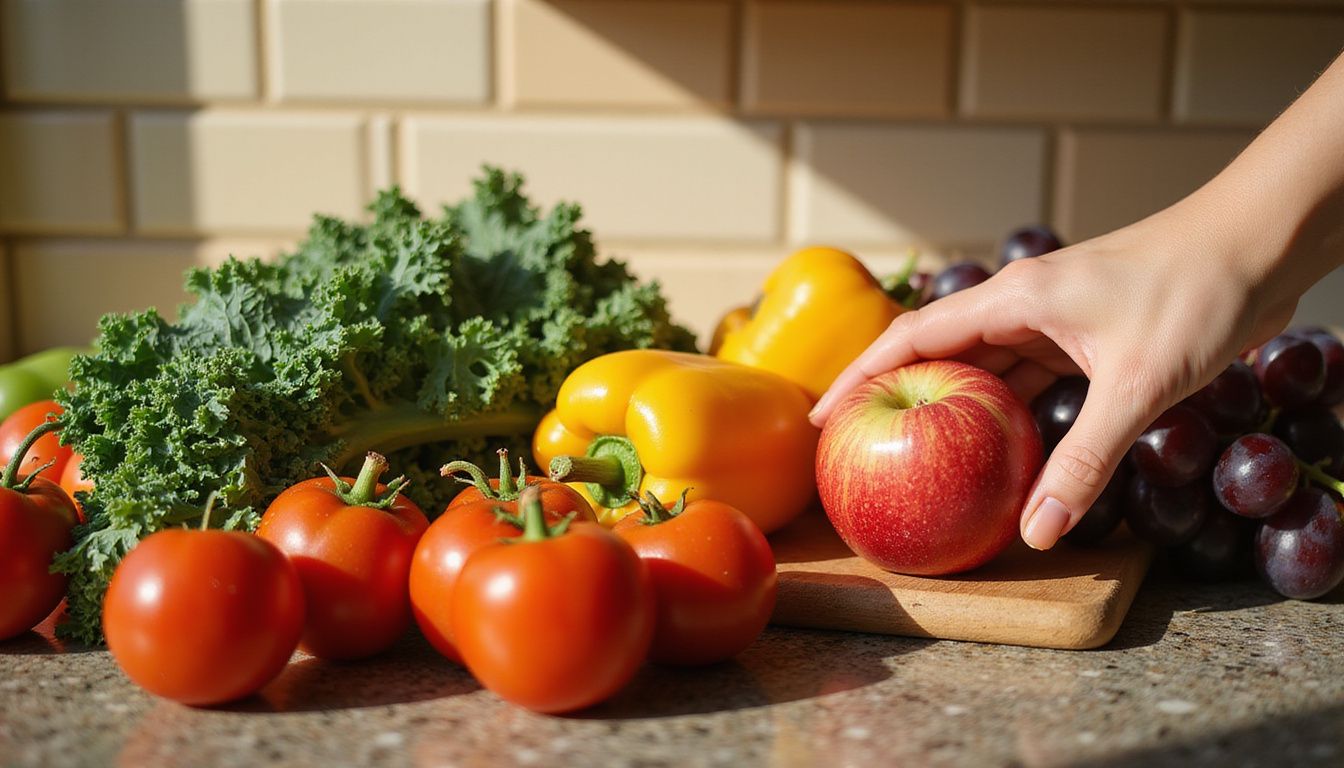Nutrition Eats: The Key To Healthy Eating And Optimal Nutrition
Our Nutrition Assistant AI Suite will transform your body. You will lose fat, get toned, and build muscle. Gain confidence and optimal health.
Healthy eating can feel confusing. Advice is everywhere, and much of it conflicts. Focusing on simple nutrition habits lowers disease risk and helps your body work its best.
Nutrition Eats offers clear tips from registered dietitians, healthy recipes, and small steps that make change stick. Keep reading for practical strategies you can start today.
Key Takeaways
- Research from USDA and Nutrition.gov shows that balanced meals with whole grains, lean proteins, fruits, and vegetables can lower the risk of heart disease and type 2 diabetes.
- Limiting processed foods, added sugars, and sodium, including plans like DASH or Whole30, supports better blood pressure control and heart health.
- Meal planning, slow cookers, careful label reading, and portion control help manage weight, a pattern supported by studies from the Cornell Food and Brand Lab.
- Choosing organic for select produce, guided by Environmental Working Group lists, may reduce pesticide exposure. Cooking more at home also cuts unnecessary additives.
- Dietitians recommend hydrating with water and water-rich foods like cucumbers or melons to support energy, digestion, and overall nutrition.

What Are the Basics of Healthy Eating?

Healthy eating starts with choosing nutritious foods from every food group. Balanced meals help you get the right mix of protein, fiber, vitamins, and minerals for strong health.
Why Are Balanced Meals Important?
Balanced meals give your body the protein, fat, and carbohydrates it needs. Each nutrient plays a different role in your heart, muscles, brain, and hormones. A one-pan Cheesy Chicken and Rice Skillet, for example, combines lean meat, grains, dairy, and veggies for balance.
Fiber from beans, whole grains, and vegetables supports steady digestion. Balanced plates can also help manage blood sugar, which keeps energy steady during the day.
Variety matters. Fruits, vegetables, grains, dairy, and proteins each add unique vitamins and minerals, such as vitamin C from citrus or potassium from tomatoes.
USDA Dietary Guidelines link nutrient-rich meals with stronger bones and a lower risk of heart disease. I started planning meals around core food groups last year. On days I skipped veggies or protein, my energy dipped.
“A healthy diet is one that helps maintain or improve health,” says the Academy of Nutrition and Dietetics.
Simple recipes like Easy Vegetable Soup or an Orange Coconut Breakfast Bowl can help you meet daily guidance. This approach satisfies cravings and supports healthy blood pressure and blood sugar.
What Roles Do Macronutrients and Micronutrients Play?
Macronutrients are carbohydrates, proteins, and fats. They provide energy and help build or repair tissues. Carbohydrates, like those in Peanut Butter Pancakes, fuel movement and brain work. Proteins from poultry in Baked Chicken Tacos support muscle repair and keep you full. Healthy fats from olive or canola oil can improve cholesterol and help you absorb fat-soluble vitamins A, D, E, and K.
Micronutrients are vitamins and minerals found in vegetables, fruit, nuts, seeds, and dairy. They support your immune system, wound healing, fluid and blood pressure balance through sodium and potassium, and strong bones through calcium.
Roasted Tomato Salsa adds vitamin C for immune support, while leafy greens supply iron to help prevent anemia. Changing your breakfast fruit or grain can boost micronutrient variety.
Meals that emphasize nutrient diversity support long-term goals highlighted by Nutrition.gov and eating plans like DASH.
Key Principles of Optimal Nutrition
Think of these principles as lane markers that keep daily choices on track.
Why Should You Emphasize Whole Foods?
Whole foods, such as vegetables, fruits, whole grains, and lean proteins, deliver more natural nutrients and less sodium and sugar. A Best Veggie Bagel Sandwich, layered with hummus, cream cheese, and crisp vegetables, uses real ingredients without extra additives.
You generally absorb more vitamins and minerals from meals made with whole foods than from ultra-processed choices. Easy Vegetable Soup, with carrots, celery, and potatoes, is a nutrient-rich example made from pantry staples.
Cooking at home gives you control over ingredients and portion sizes. My energy improved after I chose more whole-food meals like One Pot Creamy Vegetable Spaghetti and the Orange Coconut Breakfast Bowl. These meals offer fiber, flavor, and steady energy.
Following USDA guidance, a whole-food pattern helps reduce added sugars, supports heart health, and lowers the risk for chronic disease.
How Can You Limit Processed and Sugary Foods?
Start with simple swaps. Choose homemade roasted tomato salsa and Cinnamon Vanilla Protein Bites instead of packaged snacks. Shop for fresh produce at farmers markets and make low-sugar recipes such as Low Carb Chili or Easy Vegetable Soup.
Prep a few items ahead to reduce reliance on convenience foods. Replace sugary drinks with water or unsweetened beverages. Grill, sauté, or bake instead of ordering fast food. These methods help you manage added sugar, salt, and preservatives.
Limiting processed and sugary foods begins with simple swaps you can make every day.
Small changes add up. Pick two swaps this week and build from there.
Why Is Hydration Important for Nutrition?
Hydration affects every system in your body. Water helps move nutrients to your cells and supports metabolism, the process that turns food into energy.
Nutrition coaching often suggests adding water-rich produce like cucumbers, citrus, and melons to daily meals. Nutrition.gov notes that these foods support both hydration and nutrient intake.
Hydration is a core part of the DASH diet, which helps manage high blood pressure. Leafy salads, such as a Seared Ahi Salad, add vitamins and helpful fluids.
Drinking enough water aids digestion, reduces fatigue during meal prep, and can help control appetite throughout the day.
What Are the Benefits of Healthy Eating?
Choosing healthy foods and beverages brings noticeable benefits. Nutrition Eats highlights how daily habits make healthy living easier and more enjoyable.
How Does Healthy Eating Improve Physical Health?
Nutrient-dense meals support strong muscles, bones, and organs. Whole grains, lean proteins like soy or chicken, fruits, and vegetables help your heart work better.
Nutrition.gov explains that limiting saturated fat and dietary cholesterol supports heart health. Choosing low-fat dairy and lean meats can help maintain healthy cholesterol levels.
Vitamins and minerals from a wide variety of foods strengthen your immune system. Many people report fewer digestive issues when they eat more fiber-rich meals like Easy Vegetable Soup or Low Carb Chili.
Hydration helps your body absorb nutrients and supports regular digestion. People often notice steadier energy, clearer thinking, and a more balanced mood.
How Can Nutrition Boost Mental Clarity and Mood?
Balanced meals do more than fuel muscles. They support mood and focus by keeping blood sugar steady. Slow-digesting carbs, like oats and fruit in the Orange Coconut Breakfast Bowl, may improve concentration and reduce afternoon slumps.
High-fiber foods and a mix of nuts, fruits, and vegetables support brain health. Quick snacks such as Cinnamon Vanilla Protein Bites provide energy without a sugar crash.
Coffee and dark chocolate can lift your spirits, something Melanie enjoys as a personal preference. Reading labels helps you avoid allergy triggers or additives that can affect how you feel.
Personalize your plan. Choosing foods you enjoy makes healthy eating easier to maintain.
How Does Diet Help Prevent Long-Term Diseases?
A whole-food eating pattern and fewer processed items can lower the risk of obesity, diabetes, and high blood pressure. The DASH diet, featured on Nutrition.gov, is shown to reduce high blood pressure.
Filling half your plate with vegetables and fruit and adding lean proteins at each meal supports blood sugar control. GLP-1, a hormone that helps regulate blood sugar, responds well to high-fiber meals and steady eating patterns.
Dishes like Low Carb Chili and One Pot Creamy Vegetable Spaghetti can fit Whole30 or paleo styles. Buying fresh produce at farmers markets also reduces your use of packaged foods.
USDA FoodData Central helps you check nutrition numbers so you can make informed choices for long-term health.
How Can You Build Healthy Eating Habits?
Small, steady changes lead to strong habits. Start where you are and build a routine that fits your life.
What Are Effective Meal Planning and Preparation Tips?
Meal planning helps you eat well and save time. These steps make it easier to get started and stay consistent.
- Make a weekly meal plan and grocery list before shopping. Any plan helps you begin.
- Choose whole foods over processed items to boost nutrition and limit added sugars.
- Use kitchen tools like a slow cooker for easy, hands-off meals on busy days.
- Prep ingredients in advance, such as washing vegetables or cooking grains, to cut time later.
- Pack balanced lunches with protein, whole grains, fruit, and sautéed vegetables for steady energy.
- Practice portion control using smaller plates or pre-portioned containers to avoid overeating.
- Read labels. Compare calories, sugar, and ingredients using USDA FoodData Central as a guide.
- Store leftovers in clear containers so healthy options are the first thing you see.
- Keep healthy snacks like protein bites or cut fruit ready to prevent impulse choices.
- Contact Registered Dietitian Nutritionist Kailee for 1:1 support if you want personalized meal prep strategies.
Using evidence-based resources makes planning easier and helps your routine stick.
How Do You Practice Portion Control?
Portion control supports a healthy weight and a balanced diet. These simple steps work in real life.
- Use smaller plates and bowls to reduce serving sizes. Research from the Cornell Food and Brand Lab shows this can lower calorie intake.
- Build balanced plates with protein, whole grains, and vegetables. Baked Chicken Tacos or One Pot Creamy Vegetable Spaghetti make portioning simple.
- Prepare grab-and-go snacks like Cinnamon Vanilla Protein Bites to support steady energy and reduce overeating.
- Check serving sizes on nutrition labels to track calories and nutrients accurately.
- Store leftovers right after serving to make second helpings less tempting.
- Pack lunches in compartment containers to keep portions of each food group in check.
- Seek nutrition coaching if you want help estimating portions or selecting supplements.
How Can You Read Food Labels Effectively?
Label reading turns the package into a useful guide. Labels list calories, macronutrients like protein and carbs, and micronutrients such as vitamins and minerals.
Use Nutrition.gov for step-by-step guides, or compare foods in USDA FoodData Central. Start with the ingredient list. Shorter lists usually mean less processing. Swapping store-bought salsa for homemade versions reduces additives and extra sugar.
For allergies or special needs, check for major allergens, including sesame added in 2023. A coach can help you tailor label reading to your goals.
Nutrient breakdown example:
| Nutrient | Daily Value (%) per serving |
|---|---|
| Protein | 6% |
| Dietary Fiber | 10% |
| Total Sugars | 1 g |
| Sodium | 5% |
Using credible resources at every life stage keeps choices clear and reduces confusion from marketing claims.
What Are Some Nutritious Recipes to Try?
Adding variety makes healthy eating easier. These simple, whole-food recipes fit busy schedules and support a balanced diet.
Peanut Butter Pancakes
Peanut butter pancakes offer a protein-rich breakfast that fits tight mornings. This recipe uses pantry staples and comes together in minutes.
The pancakes supply steady energy and work well for school days or busy work mornings. Each serving provides a mix of protein and carbs, similar to protein bites many families enjoy.
On hectic days, the batter mixes in minutes and cooks in under 15. My kids love the warm, soft texture, and I like the satisfying taste.
They make a practical, nutritious choice without sacrificing flavor.
Easy Vegetable Soup
This soup is ready in under 30 minutes, which makes it great for weeknights. Carrots, celery, zucchini, and tomatoes add a wide range of vitamins and minerals.
The recipe is gluten free and vegetarian. It fits many diets without losing flavor or texture.
Fresh vegetables in your dinner routine help you meet nutrition goals. After work, a bowl leaves you full but light, thanks to the fiber.
Honey Peanut Chicken Satay
Honey Peanut Chicken Satay makes a fast main dish or appetizer. It brings lean protein and big flavor with pantry items.
Skewers of chicken are seasoned with PB2 powdered peanut butter and honey, then grilled. The sweet and savory coating creates a satisfying balance without heavy sauces.
This recipe was sponsored by PB2 and became a go-to at my house. It works for gatherings or a simple weeknight meal.
Kids and adults enjoy the flavor, and you get protein and healthy fats in every bite.
Baked Chicken Tacos
Baked chicken tacos are family friendly, quick, and nutritious. Shredded chicken, black beans, and diced tomatoes provide protein, fiber, and vitamins.
Use a hybrid method. Cook the chicken in a slow cooker, then fill taco shells and bake until crisp. This saves time and builds flavor.
The recipe was shared on August 5, 2019. It was sponsored by General Mills, and all opinions remained personal. Toppings are flexible, so you can add lettuce, salsa, or avocado.
Making a batch at once feeds a group or sets you up with leftovers for lunch.
Low Carb Chili
This hearty chili skips beans and relies on whole ingredients. It fits paleo and Whole30 diets and uses lean ground beef or turkey, bell peppers, tomatoes, and classic spices.
Keeping it bean free lowers carbohydrates while still feeling filling. The dish became a family favorite when we wanted a lighter option with bold flavor.
Each batch avoids added sugar and fillers. Serve it hot at dinner as part of a balanced meal plan.
Cinnamon Vanilla Protein Bites
These no-bake protein bites are quick, portable, and gluten free. Oats and nut butter add fiber and protein for steady energy.
They work as a snack or a fast breakfast. Portion-controlled servings help you practice mindful snacking throughout the day.
They also support higher protein intake for muscle recovery after exercise.
One Pot Creamy Vegetable Spaghetti
This gluten free dinner cooks in a single pot. Broccoli, bell peppers, and spinach brighten the dish and boost vitamins and minerals.
Combine gluten free spaghetti with vegetables and a dairy or plant-based cream sauce. The result is a creamy texture with simple cleanup.
It fits busy weeknights and keeps home cooking convenient. Families report this recipe shows up often because kids like the creaminess and adults value the balance.
It is a practical way to build a nutrient-dense dinner from everyday ingredients.
How Can Meal Prep Help You Succeed?
Meal prep helps you stick to your goals. It saves time and keeps healthy choices within reach.
What Are Easy Tips for Packing Balanced Lunches?
Packed lunches fuel your day and keep nutrition on track. Use these ideas as a checklist.
- Use a divided container to portion whole grains, lean proteins, and two vegetables.
- Choose make-ahead items like Cinnamon Vanilla Protein Bites, Easy Vegetable Soup, or The Best Veggie Bagel Sandwich.
- Add fresh fruit or cut vegetables for fiber and hydration, such as apples or carrots.
- Pick whole grain bread or tortillas to raise fiber and reduce sugar spikes.
- Include lean proteins like turkey, eggs, tofu, or low-fat cheese for fullness and muscle support.
- Batch-cook on weekends to ease busy mornings during the week.
- Skip most packaged snacks to avoid extra salt and sugar. Roast chickpeas or pack nuts instead.
- Read labels for sodium and fat to match your goals, a tip aligned with Nutrition.gov.
- Rotate recipes for variety, such as Low Carb Chili one day and Baked Chicken Tacos the next.
- Keep a water bottle handy to support digestion and nutrient absorption.
Consistent lunch prep makes busy days easier and keeps your choices aligned with your goals.
What Time-Saving Strategies Work for Busy Lifestyles?
Healthy eating does not need to be time consuming. Plan once, cook smart, and repeat what works.
- Prep vegetables and proteins on Sunday to cut weeknight cooking under 15 minutes.
- Choose recipes like Easy Vegetable Soup or One Pot Creamy Vegetable Spaghetti that cook in under 30 minutes.
- Double recipes such as Low Carb Chili or Baked Chicken Tacos and freeze half for later.
- Rely on no-bake snacks like Cinnamon Vanilla Protein Bites for fast fuel.
- Portion meals into containers right after cooking for grab-and-go options.
- Rotate five to seven simple recipes to keep shopping lists short and reduce waste.
- Shop farmers markets on weekends for fresh produce that lasts through the week.
- Set aside one evening for meal planning, using Nutrition.gov or FoodData Central as guides.
- Repurpose leftovers, such as turning roasted vegetables into wraps or salads.
- Use slow cookers, sheet pans, or rice cookers for easy, hands-off meals.
- Share tasks. Kids can portion snacks or help pack lunch boxes.
Nutrition for Specific Needs
Personal needs vary. Tailoring your eating pattern can help you manage conditions and feel better day to day.
How Can Diet Help Manage Diabetes?
Balanced meals built from whole foods help stabilize blood sugar. Low carb recipes such as Low Carb Chili or Whole30 options can reduce spikes.
Portion control reduces sudden rises in glucose. GLP-1, a hormone that helps control blood sugar, tends to respond well to high-fiber meals and consistent eating times.
Use a food tracking app for patterns you can adjust. Nutrition.gov and diabetes-focused coaching programs offer reliable guidance. USDA FoodData Central provides helpful numbers for daily decisions.
What Are Heart-Healthy Eating Plans?
Heart-healthy plans keep saturated fat, sodium, and cholesterol lower while raising intake of fruits, vegetables, whole grains, and healthy fats. Nutrition.gov recommends the DASH diet for people with high blood pressure because it limits sodium and highlights potassium-rich foods like leafy greens and berries.
Farmers markets are good places to find fresh produce for your week. Recipes like Easy Vegetable Soup or One Pot Creamy Vegetable Spaghetti are high in fiber and lower in unhealthy fats.
Reducing daily sodium below 2,300 milligrams is linked to lower heart disease risk in USDA guidance. Reading labels helps you limit hidden sodium and trans fats.
How Is Nutrition Used for Weight Management and Bariatric Care?
Personalized plans support weight goals with nutrient-dense meals that fill you up for fewer calories. Low Carb Chili and Cinnamon Vanilla Protein Bites are examples that help with portions and satisfaction.
Before or after bariatric surgery, a targeted plan ensures enough protein and vitamins. Experts on Nutrition.gov offer science-based tips at each stage of life.
Coaching can help you build habits that last so progress continues long term.
How Can You Reduce Toxins in Your Diet?
Small choices add up. Focus on fresh food, smart shopping, and simple cooking methods.
Why Choose Organic Produce?
Organic produce can reduce exposure to certain pesticides. The Environmental Working Group lists items like strawberries and spinach that often carry higher residues when grown conventionally.
Shopping at local farmers markets makes it easier to find organic or low-spray options. Many Nutrition Eats recipes show how to use these foods daily.
After shifting to mostly organic for certain items, my meals tasted fresher. USDA FoodData Central can help you compare nutrition details while you shop.
How to Avoid Harmful Additives and Preservatives?
Choosing organic is one step. Daily habits matter too. Make more homemade recipes, like Roasted Tomato Salsa or Cinnamon Vanilla Protein Bites, to reduce additives found in packaged snacks.
Read labels and look for terms like BHA, BHT, or artificial colors, which indicate preservatives. Planning meals in advance increases control over ingredients and sodium.
When I started prepping lunches with local produce, I noticed fewer headaches and fewer ultra-processed snacks. FoodData Central is useful for checking ingredients before you buy.
How Do You Separate Nutrition Facts from Fiction?
Nutrition claims appear online every day. Use evidence-based sources to confirm what you hear and see.
What Are Common Diet Myths Debunked?
- “Carbs make you gain weight.” Registered Dietitian Nutritionist Kailee notes that whole grains supply fiber, vitamins, and energy. Cutting all carbs can drain energy and affect focus.
- “All fats are bad.” Some fats help your body. Choose avocados, nuts, and olive oil for healthy unsaturated fats that support heart health.
- “Supplements replace real food.” Nutrition.gov explains that pills cannot match the full benefits of balanced meals rich in protein, vitamins, minerals, and fiber.
- “Organic foods always have more nutrients.” Organic choices can reduce pesticide exposure. USDA data shows nutrient content can be similar between organic and non-organic options.
- “You need lots of protein shakes to build muscle.” Most people can meet protein needs with lean meats, beans, dairy, or tofu rather than powders.
- “Skipping meals helps with weight loss.” Skipping meals often slows metabolism and increases cravings later in the day, according to summaries on Nutrition.gov.
- “Gluten-free diets are healthier for everyone.” Unless you have celiac disease or gluten sensitivity, removing gluten is not shown to improve health for most people.
- Sponsored posts should disclose relationships, as this blog does. Not every influencer has formal training, so check facts with USDA FoodData Central.
Where Can You Find Credible Nutritional Resources?
Nutrition.gov, powered by USDA science, offers expert guidance, tips for every life stage, and seasonal recipes. It is a reliable starting point for most questions.
USDA FoodData Central lists detailed nutrient data for more than 400,000 foods. Check it to verify calories, fiber, sodium, and more.
The National Agricultural Library hosts digital exhibits about food and farming. The Historical Dietary Guidance Collection shows how recommendations evolved over time.
This blog links to reputable sources, including Nutrition.gov, to support your journey with trustworthy information.
What Resources Support Healthy Eating?
Trusted resources help you cut through noise and stay consistent with healthy eating.
USDA FoodData Central
USDA FoodData Central gives nutrient details for a wide range of foods. Use it to check calories, protein, fat, vitamins, and minerals before you plan meals or read labels.
The database connects with Nutrition.gov to streamline research. If you manage diabetes or heart disease, these numbers help you tailor choices. I often use FoodData Central to confirm carbohydrates in snacks before I shop.
It is free, public, and helpful for evidence-based decisions.
Farmers Markets for Fresh, Local Produce
After checking nutrition data, find fresh, seasonal produce at farmers markets. Nutrition.gov highlights how local markets support access to fruits and vegetables year-round.
Market produce is often fresher with shorter storage time, which can help preserve flavor and some nutrients. Choosing organic or low-spray items can also reduce exposure to certain chemicals.
I often plan the week after a market visit. Grilled zucchini on salads and apples in oatmeal make meals simple and tasty.
Nutrition.gov for Expert Guidance
Nutrition.gov provides expert, science-backed advice on healthy eating, activity, and disease prevention. You will find sections on managing blood pressure and diabetes, plus practical webinars.
The site includes market guides and seasonal recipes. Follow Nutrition.gov on Twitter for updates that can spark new meal ideas.
Credible information makes it easier to choose foods that fit your goals.
Conclusion
Healthy eating starts with small, daily choices. Balanced meals, simple meal prep, and a few favorite healthy recipes can make nutrition feel doable, even on busy days.
Plan your week, cook mostly whole foods, and keep water close. If you need personalized advice, speak with a registered dietitian or your healthcare provider. Resources like Nutrition.gov and USDA FoodData Central can guide decisions with reliable data.
With clear guidance, steady habits, and practical tools, you can build a healthy diet that supports long-term energy and well-being.
FAQs
1. What are the main principles of healthy eating for optimal nutrition?
Healthy eating focuses on consuming a variety of whole foods, such as fruits, vegetables, lean proteins like poultry or fish, and whole grains. Research from the Centers for Disease Control and Prevention shows that diets rich in these foods support heart health and lower chronic disease risk.
2. How can I use Nutrition Eats to improve my daily food choices?
Nutrition Eats offers evidence-based guidance to help you select nutrient-dense options at each meal. For example, replacing refined grains with brown rice or quinoa increases fiber intake; this supports digestive health according to studies published in The American Journal of Clinical Nutrition.
3. What nutrients should I prioritize for balanced meals?
Balanced meals should include protein sources such as eggs or beans, complex carbohydrates like oats or barley, healthy fats from nuts or seeds, and plenty of colorful produce. Data from Harvard T.H. Chan School of Public Health suggests that this combination provides essential vitamins and minerals needed for energy and growth.
4. Can personal experience help me stick to healthier habits?
Personal stories often make nutrition advice more relatable; when I started preparing weekly menus using simple recipes with fresh ingredients like spinach salads or grilled chicken wraps, it became easier to maintain good habits over time.
Summary: Healthy eating relies on choosing varied whole foods while focusing on key nutrients at every meal. Evidence-based tips combined with practical strategies can guide better decisions each day.







